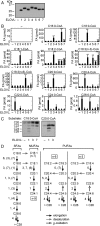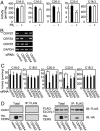ELOVL1 production of C24 acyl-CoAs is linked to C24 sphingolipid synthesis
- PMID: 20937905
- PMCID: PMC2973002
- DOI: 10.1073/pnas.1005572107
ELOVL1 production of C24 acyl-CoAs is linked to C24 sphingolipid synthesis
Abstract
Very long-chain fatty acids (VLCFAs) exert a variety of cellular functions and are associated with numerous diseases. However, the precise pathway behind their elongation has remained elusive. Moreover, few regulatory mechanisms for VLCFAs synthesis have been identified. Elongases catalyze the first of four steps in the VLCFA elongation cycle; mammals have seven elongases (ELOVL1-7). In the present study, we determined the precise substrate specificities of all the ELOVLs by in vitro analyses. Particularly notable was the high activity exhibited by ELOVL1 toward saturated and monounsaturated C20- and C22-CoAs, and that it was essential for the production of C24 sphingolipids, which are unique in their capacity to interdigitate within the membrane as a result of their long chain length. We further established that ELOVL1 activity is regulated with the ceramide synthase CERS2, an enzyme essential for C24 sphingolipid synthesis. This regulation may ensure that the production of C24-CoA by elongation is coordinated with its utilization. Finally, knockdown of ELOVL1 caused a reduction in the activity of the Src kinase LYN, confirming that C24-sphingolipids are particularly important in membrane microdomain function.
Conflict of interest statement
The authors declare no conflict of interest.
Figures





References
-
- Hodson L, Skeaff CM, Fielding BA. Fatty acid composition of adipose tissue and blood in humans and its use as a biomarker of dietary intake. Prog Lipid Res. 2008;47:348–380. - PubMed
-
- Mizutani Y, Mitsutake S, Tsuji K, Kihara A, Igarashi Y. Ceramide biosynthesis in keratinocyte and its role in skin function. Biochimie. 2009;91:784–790. - PubMed
Publication types
MeSH terms
Substances
LinkOut - more resources
Full Text Sources
Other Literature Sources
Molecular Biology Databases
Miscellaneous

